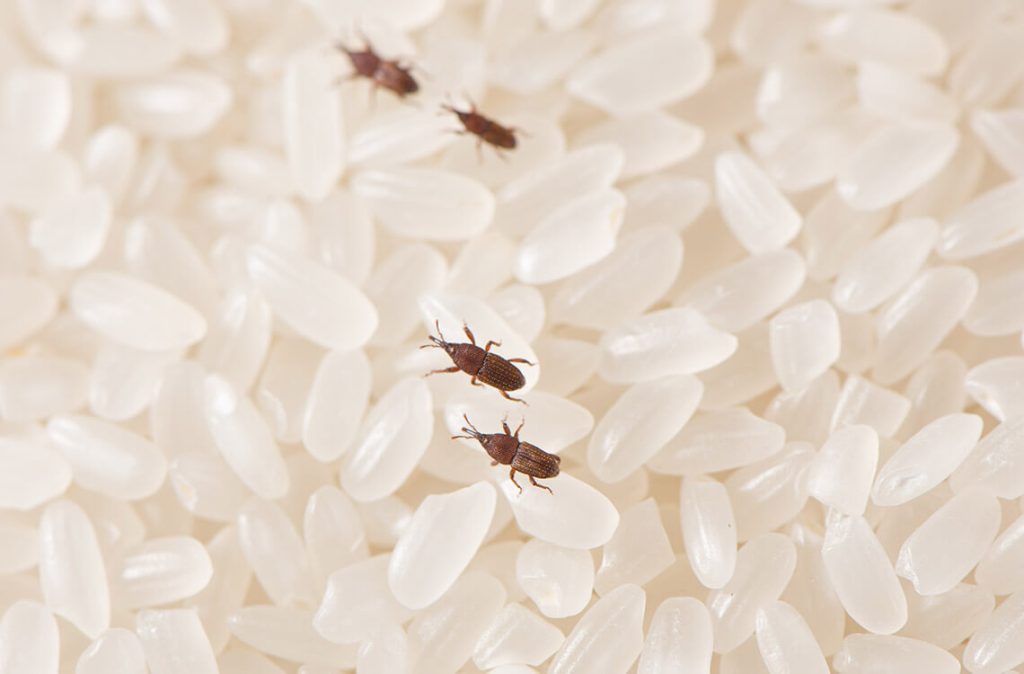Rice is the bread and butter of Malaysian cuisine; it’s our main carbohydrate and source of pleasure.
But it can also come with a few uninvited passengers. If you’ve ever kept rice at home in those big plastic sacks, you’ll probably across the well-known and common pest.
Known widely in Malay as ‘kutu beras’ or rice lice, weevils are a type of insect that feeds on starch. Before we learn how to get rid of them from our home, let’s learn a bit of what ‘kutu beras’ actually are.
What Are ‘Kutu Beras’ or Weevils
“Kutu Beras” is a Malay term that translates to ‘rice weevils’ or ‘rice bugs’. They are small, practically microscopic beetles that infest rice and other grains.
The get their main food by feeding on the starch and nutrients within the grains. Rice weevils are common pests in many parts of Asia, and can be a nuisance for both homeowners and farmers.
This is because they can easily contaminate and damage food if left to multiply.
Rice weevils be difficult to detect until they infest a significant quantity of rice. Infested grains may develop small holes, and the weevils themselves can be found inside the grains.
If you’re dealing with weevil problems in your house, it’s important to take action to eliminate them immediately. Before they grow in numbers. But rice isn’t their only favourite delicacy.
They are known to infest grains like oats, flour, bread, and other dry goods.
How To Deal With A Weevil Problem
Identify the Source
The first step is to identify the source of the infestation.
Check your pantry and storage areas for any opened or unsealed dry goods, such as rice, flour, cereal, pasta, or pet food.
Weevils often enter your home through contaminated food products. Most often, rice. Unfortunately there is no way to complete eradicate weevils from rice products.
Once you identify the source, separate it from your other food.
Dispose of Infested Items
Any food items that show signs of weevil infestation should be discarded immediately.
Seal them in a plastic bag before disposal to prevent further spread.
Washing or cleaning them is usually not enough. Weevils not only eat rice, but they also bury their eggs in the rice grains.
These eggs will later hatch and start the infestation all over again. Be sure to check nearby items as well, as weevils can easily move from one food source to another.
Deep Cleaning
Sometimes removing the source of the infestation may not be enough. Empty out your pantry and storage areas. Check all the foodstuff that may be prone to weevil infestation.
Anything that isn’t stored in an air-tight container such as tins.
Remove all food items and clean the shelves, cracks, and corners with a vacuum cleaner or a damp cloth to eliminate any weevils or their eggs. Continually inspect your stored food items for signs of weevils.
Early detection can help prevent a full-blown infestation.
Store Food Properly
The best way to prevent weevil infestation is to stop it from happening at all.
As they say, prevention is better than cure. To prevent future infestations, store dry goods in airtight containers made of glass, plastic, or metal. Weevils can’t penetrate these containers, keeping your food safe.
When using plastic, make sure to use a thick container.
Weevils are known to bite and burrow through thin plastic containers. Including rice packets, flour packets and bread packets.
Freeze or Heat Treat
Sometimes storing them is not enough, especially if there are already weevils or weevil eggs in the food.
Rice for instance will have some weevils or weevil eggs in it even if it’s been cleaned thoroughly.
If you suspect any newly purchased dry goods might be infested, consider freezing them for a few days. Alternatively, you can keep rice in the fridge indefinitely if you have space.
Heating works best for whole grains like rice. Heat your oven to 60°C and lay your grains out on a baking sheet. Bake for no longer than 15 minutes.
Professional Pest Control
Sometimes no matter what you do or what you’ve tried, the weevils keep coming back.
If you have a recurring or severe weevil in your home, it’s time to consult a professional pest control service.
They can assess the situation and use appropriate measures to eliminate the problem. Depending on the level of infestation, you may be looking at a few hundred ringgits.
Natural Repellents
You should never use chemical or synthetic pesticide on rice, or any food that you intend to eat.
But that doesn’t mean there aren’t any natural pesticides you can use. Some natural repellents can help deter weevils. Bay leaves are known to have a mild repellent effect on weevils.
Place them in your pantry and storage areas. Other repellents include clove, rosemary, black pepper corns, and garlic cloves.
However these have a smaller rate of success than freeze or heat treating the rice.
Bust those Rice Mites
Remember that patience and persistence are essential when dealing with ‘kutu beras’.
It may take some time to completely eliminate them. And even longer to prevent re-infestation. Sometimes professional help may not be needed.
Regular maintenance and vigilance is all that is needed. With a little patience, you can have a weevil-free home in no time.
Disclaimer: The information provided in this article is for informational purposes only and should not be considered as medical advice from Motherhood. For any health-related concerns, it is advisable to consult with a qualified healthcare professional or medical practitioner.
For more insightful stories and fun recipes, stay tuned to Motherhood Story!
